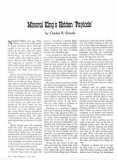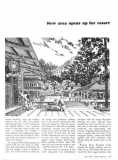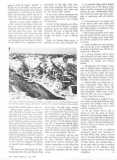


NINETY-THREE years ago, Wiley Watson, one of the earliest mayors of Visalia, California, had a dollar-sign twinkle in his eye and a promotion scheme up his sleeve which has earned for him the distinctive title, "prophet of Mineral King." Up until recently, that monicker didn't mean tiddle-de-winks to anyone. But the name Mineral King is now beginning an ascension in fame which could surpass almost any mountain area in the world, Zermatt, Garmisch, Interlaken, Sun Valley and Aspen included.
Back in 1873, Wiley Watson first promoted the building of a road from his hometown of Visalia in the San Joaquin Valley to the Mineral King District, a high valley in the Sierra Nevada Mountains rich in wildlife, timber, beauty and, much to Watson's delight, minerals. The Mineral King Silver Rush had begun and Watson concluded that his road would greatly benefit local merchants and farmers who ship their produce to the mines if a large settlement should develop there. A wise investor, our good man wasn't placing all his silver ingots into one bread basket. If the silver played out and the boom was a bust, Watson argued that a road could be used to capitalize on the beautiful scenery which would draw sightseers to Mineral King. The valley is surrounded by half a dozen majestic peaks approaching an elevation of 12,000 feet.
Watson himself never did completely finish his road. The magnificent yet awful mountains around the 8,000-foot Mineral King Valley have, for decades, resisted man's efforts to develop the area. But Watson was undoubtedly the first to gaze past the glitter of silver that blinded every clodhopper and mucker in the state in those days to see profit in the awesome beauty of the jagged, granite peaks.
When California's own Walt Disney, a "bonanza" king in his own right, first stared in amazement at Mineral King's panorama of sawtooth peaks and timber covered slopes, he envisioned a project that would permit you and me and little Johnny Gitalong next door to behold and savor this wonderful sight.
In late December of 1965, Mr. Disney was notified that his plans for the development of a $35,000,000 summer and winter recreational facility at Mineral King had been accepted by the Department of Agriculture and the United States Forestry Service. So, the claim for Mineral King's second and biggest payload has finally been staked out and, after all these years, Wiley Watson's comments about tourist trade in the Sierras is remembered.
The project which conservation-minded Mr. Disney (he is honorary president of the National Wildlife Federation and honorary member of the Izaak Walton League, among others) is now beginning has the populace of San Joaquin as well as Los Angeles, San Francisco and Sacramento about as excited as the hill-and-gully-thumping miners of old Porterville were when James A. Crabtree revealed his find at Mineral King.
Something of a spiritualist, Crabtree told a tale of discovery involving a White Indian Chief who appeared to him in a dream and pointed out the path to follow for riches. Upon awakening, he and a friend left at once for the mountains. When they returned to Portervilie in the foothills, they jointly filed claim to The White Chief Lode. The old sourdoughs in town may have laughed at Crabtree's tall story, but not too loudly. He had a reputation as a successful prospector and the ore samples he carried in his poke helped to spread the fever that started Mineral King booming.
During the first winter of the rush when snow kept the miners from working their claims, Tulare County spirits were mighty high. Every discussion embraced the Mineral King mines. Potential millionaires roamed the streets of Porterville and Visalia boasting of the richness of their claims and dreaming of silver, mansions and servants. Rumors rolled freely as they always did in a mining community and there was considerable counting of silvery chickens, so to speak, before the eggs were even laid.
A town which included saloons, mill sites, boarding houses, general stores and a livery stable was eventually built in the high valley and named Beulah, meaning the land of promise. It was a typical boom town, but the lack of violence in the district was something of an oddity for those days. There were fist fights, a shooting, a suicide, a couple of mob hanging threats and a few dynamite accidents, but all in all the boom town was a pleasant place to work.
Although work was pushed twenty-four hours a day and explosions echoed around the peaks every few minutes, progress was slow. Mineral King was and is an extremely difficult place to reach. Twenty-five miles of precipitous trail through country that has been compared only to the Swiss Alps by top ski champions and geologists presented an overwhelming problem to the miners. Today, before Disney can proceed with full development, an all weather road expected to cost some three million dollars must be constructed for easy access.
One of the major problems for the miner in the early days was his lack of adequate drilling tools. But they used good ol' American ingenuity and started busting rocks with heat. Huge bonfires were built on the rock and kept going all night. When cold water was thrown on the hot rocks, they would crack and split open. Powder was then packed into the cracks and touched off to shatter the rock.
Residents of Beulah had to be alert for they lived in a veritable bowling alley with tenpins anything in sight. With careless miners blasting the steep-sloped granite mountains, rocks and boulders careened into the valley and tumbled right through town. In the writings of one Orlando Barton, a law "requiring miners to keep their rocks on their own land," is mentioned, but evidently it wasn't enforced. The rolling stone menace became so severe that the flats of Monarch Creek were finally abandoned as a place to do business.
For 10 years Mineral King popped and boomed with ups and downs of enthusiasm that broke hearts, bankrupted rich men and brought a touch of wealth to just a few. In late summer of 1879 some 500 people were permanent residents there (a fair size for a boom town with mines yet unproven). Once the reasonable facsimile of a toll road was finished, construction increased and still more people came to scour the hills and work in the mines. To feed them, the local butchers, obtained bear meat and venison by none other than a Kentucky sharpshooter named George Washington Boone, grandson of Daniel Boone. The town was even fortunate enough to have a full-time physician. Dr. T. F. Pegg.
The first forms of recreation in this future playground were old-fashioned hoe-downs with the miners themselves providing the music. Hob-nail boots pounded the floors and the few wives who lived in town had a wonderful, if treacherous, time high-stepping with everyone. Organized Sunday baseball became so popular that the Tulare Times newspaper claimed, "politics and baseball together with silver excitement make Mineral King the liveliest place on the coast."
Mineral King flourished mainly through the energy, finances and ambition of one Tom Fowler who was convinced that these craggy mountains were going to yield the biggest "paylode" in the story. He poured money into the town, building the first stamping mill, fostering construction of a tramway to the Empire Mine and providing needed backing to finish the very narrow and dangerous wagon road that Watson had promoted.
Rumors of great wealth tumbled out of the caverns of the Empire Mine and down into central California. One report stated that the huge walls of the natural and man made eaves were "one solid mass of rich silver rock." How these tales began has never been known, but the simple fact that Fowler died a sick, broke, and exhausted man lead some to believe he had risked all on a magnificent fairytale and then failed to make it come true.
[img]An artist's rendering of proposed ski lifts and trails in the new Walt Dinsey resort. To preserve alpine setting, automobiles will not be allowed in Mineral King district.[/img]
Mineral King reached its zenith in 1879. Hundreds of people were coming and going and at the close of the year, when the snow began to fly, the miners were more hopeful than ever before. But in the following summer, dreams faded. The mountains didn't glitter as they had previously. Inadequate smelting processes prevented the mines from paying off. The zinc blends in the limestone would not yield galena in rich enough proportions. Fowler went bankrupt and other investors tightened their purse strings, considering the area too great a risk. The ore was not as rich as had been supposed. The blends of minerals made smelting too difficult to pay.
The boom town died quickly. By 1882, the Beulah, Silver City and Mineral King communities in this high valley were ghost towns. Gradually the winter snows crushed the buildings until today only the old butcher house remains.
In later years, various explorations and assays further discredited the wild declarations of the "silver fever" era in Visalia and Porterville.
Amid all of this commotion over silver, no one heard Wiley Watson's comment regarding tourists and these remarkable mountains. But now, at long last, Walt Disney has picked up this train of thought and turned it into a thrilling project.
Today, the Mineral King district is bordered on three sides by Sequoia National Forest. "Its high ridges, uniform snow conditions and breathtaking vistas make it potentially the finest ski area in the United States," says Disney. Careful and imaginative planning will preserve the natural atmosphere of this wilderness while opening it to the growing population that is increasingly seeking opportunities for outdoor recreation. Included in this planning are ten basic guidelines which Mr. Disney and his staff intend to follow in the development. They are:
1. Visitor automobiles will not enter the valley floor, but will park at the valley entry. Otherwise Mineral King's unique flavor could be destroyed. Continuous transportation on the valley floor will be by a new conveyance system aesthetically compatible with the Alpine setting.
2. A centralized village will be located at the lower end of the Mineral King valley. It will be convenient to all visitors entering the area, architecturally blending in with the terrain but with a minimum of interference with ski development.
3. A dominant goal is to preserve one of the nation's most scenic Alpine and outdoor recreational areas in its natural state while making it available for more than a limited few to enjoy.
4. The natural attractions of the entire area and certain facilities, such as warming huts, ski lounges, picnic areas, trails, etc., will be enjoyed by the public without charge.
5. Clean, healthful fun and entertainment for all age levels, compatible with an outdoor recreational area, will be provided in the village area.
6. A pricing structure will be maintained whereby such basic needs as food and lodging will be relatively inexpensive, particularly for families and summer tourists.
7. Development will facilitate enjoyment of Mineral King's wilderness and such outstanding natural features of the area as its mountain peaks and snowfields, hot springs and other mineralized springs, lakes, natural limestone caverns, waterfalls, cool summer temperatures, etc.
8. Mineral King can become the nation's outstanding winter sports area. Skiers will have a variety of terrain, ski runs, and facilities unequaled in the northern hemisphere. Other winter visitors will have their own area to engage in a variety of snow play activities.
9. No development is needed for summer visitors to enjoy Mineral King except to provide basic facilities such as food, lodging if desired, hiking trails, picnic grounds, campgrounds, etc.
10. By day visitors will be able to spread out over the miles of forests, mountains, and snowfields without crowding any area. By night Mineral King must be able to accommodate thousands of people in a cluster of essential buildings and facilities, leaving the forests and mountains to the wildlife.
Never before has such an ambitious recreational project been attempted in the High Sierras. Now, almost a century after its founding, Mineral King's hidden paylode has been discovered and claimed by Walt Disney. And certainly there is no one who would do more to maintain the reverence of the wilderness while opening the area to nature lovers from everywhere.